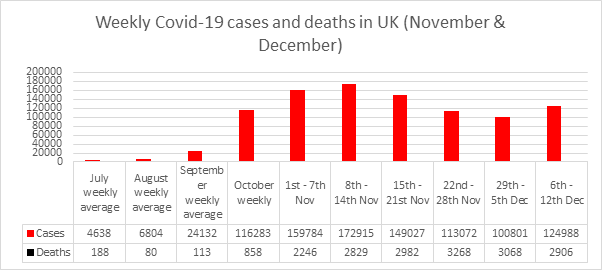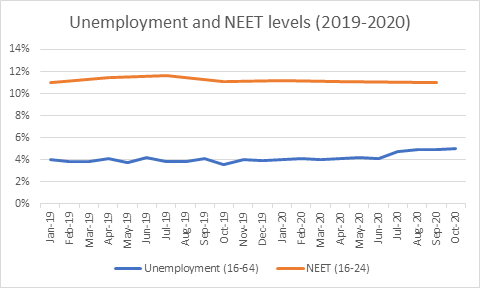This is the thirty-eighth of a series of bulletins produced by ISE to update members on key data and policy on Covid-19. This covers the period 10/12/2020-16/12/2020.
You can access all of the Covid-19 bulletins on ISE insights.
Latest Covid-19 data

Data taken from Wikipedia and from the government’s Covid-19 dashboard.
The UK has now had over 1.9 million identified Covid-19 cases and 76,287 deaths (with Covid on the death certificate). The R rate is estimated to be between 0.9 and 1 with the daily infection rate falling by -2%-0%. After three weeks of the number of cases falling, cases have started climbing again.
Covid news
- The government has announced the rules for ‘Christmas bubbles’. But, there is considerable controversy over the relaxing of national social distancing rules for Christmas. Scientists warn against Christmas gatherings and provide advice on how to keep safe.
- With cases rising again there is concern that there will be a need for a new national lockdown in 2021.
- The vaccine has started to be rolled out, but there are several logistical problems including concerns about procurement. Dozens of GP surgeries have indicated that they will not be able to administer the vaccine.
Education
- Lockdowns and Covid have created huge and locally variable gaps in school attendance this year. This raises concerns about the equity of assessments this year. Local and national government have been in a wrangle about when to close schools this term.
- New research shows that most higher education students were receiving all or most of their teaching online this year. Yet, despite concerns earlier in the year, the financial picture for higher education is looking better than anticipated.
- Postgraduate applications are rising, with new data showing an increase in applications for law conversion courses.
- There are concerns about the impact of the pandemic on university/business partnerships.
The economy and labour market

This figure uses data from the Office for National Statistics to set out the proportion of the working population who are unemployed and the proportion of young people who are Not in Education, Employment or Training (NEET). New data has just become available for October and shows another month of rising unemployment.
- Live data from the Learning and Work Institute suggests that the rates are continuing to grow throughout November.
- The number of new jobs being posted is continuing to grow, but is still a long way below the volume of new jobs advertised at the same time last year.
The student labour market
- There are considerable ongoing concerns about the growing youth unemployment crisis.
- The situation in the graduate labour market is more mixed as a recent webinar at Nottingham Trent University discussed.
- Recruitment processes continue to move online. New insights are available about running an effective digital assessment centre.
- The top 10 ISE blogs of 2020.
Changes to working life
- Most workers are in no hurry to return to their commutes and office working life. But, a long-term shift to home-working requires changes in the way that work is organised.
Employer insights
Insights gathered from ISE employer ‘town halls’ and other interactions over the last week.
- Most employers are reporting a massive spike in applications particularly in the graduate space. However the quality of these applications is very variable.
- Employers report a rise in graduates applying for apprenticeships and other non-graduate roles.
- Employers and universities both report challenges in getting virtual careers fairs and other virtual attraction approaches right. It is providing to be difficult to engage enough students in these events and to facilitate high quality interactions.
- Virtual assessment and selection processes are going well. Many employers expect to continue to use these for the foreseeable future.


0 Comments